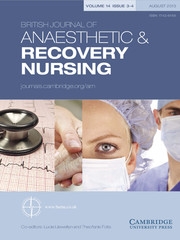No CrossRef data available.
Article contents
Students' Perceptions of Day Surgery
Published online by Cambridge University Press: 25 February 2009
Extract
At departmental meetings, it has long been commonplace for staff to play ‘Lingo Bingo’. The rules of the game are simple; one can play alone, but it is much more fun in a team. First select one word from an apparently endless list of irritating and pompous terminology and then agree a number between 5 and 10. Then sit through the meeting, counting how many times people at the gathering use the selected term. When they reach the number selected, shout Bingo! And wait for the reaction. It seems to me that NHS managers, educational institutions and of course, health ministers are all playing the game.
- Type
- Research Article
- Information
- British Journal of Anaesthetic & Recovery Nursing , Volume 2 , Issue 1 , February 2001 , pp. 10 - 13
- Copyright
- Copyright © British Association of Anaesthetic and Recovery Nursing 2001


